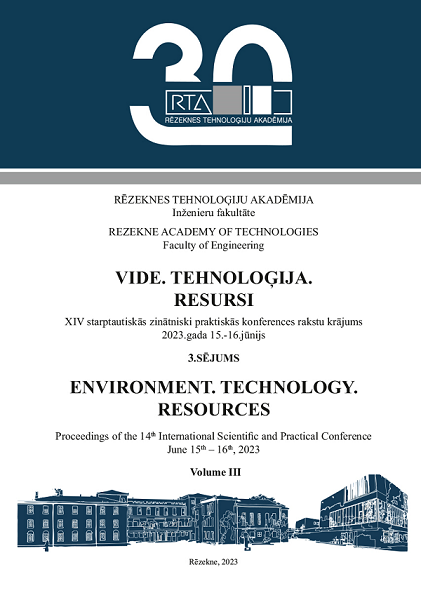INVESTIGATION OF THE INFLUENCE OF TECHNOLOGICAL PARAMETERS OF LASER MARKING ON THE DEGREE OF CONTRAST
DOI:
https://doi.org/10.17770/etr2023vol3.7319Keywords:
Laser, Marking, Contrast, Laser Power, step, Marking Speed, FrequencyAbstract
In modern production, each finished product entering the market is identified by a special marking. Each mark must meet requirements such as good coding, easy to see, easy to read by certain readers, stable over time, etc. In the present casting, laser marking of the C75 steel was carried out with a fiber laser with an average power of P = 30 W and a wavelength of λ = 1064 nm. For semi-contrast marking, marking speeds from 100 mm/s to 700 mm/s, average power from 10 to 30 W, raster pitch from 20 µm to 60 µm, scanning frequency from 20 kHz to 150 kHz were investigated as constant parameters are the pulse duration τ =100 ns, number of repetitions N = 1 and defocus Δ f = 0 mm. The influence of the changing parameters on the contrast was established, and experimental dependences were constructed. The achieved research results show that to obtain a high contrast mark, the average power should be above 20 W, the scanning speed up to 300 mm/s, the scanning frequency up to 50 kHz and the raster pitch up to 40 µm.
References
L. Lazov, H.Deneva, P.Narica,” Laser Marking Methods”, Environment Technology Resources Proceedings of the International Scientific and Practical Conference 1:108, June 2015.
M. Kučera, J. Martan and A. Franc,” Time-resolved temperature measurement during laser marking of stainless steel”, International Journal of Heat and Mass Transfer, 125, 1061–1068, 2018, doi:10.1016/j.ijheatmasstransfer.2018.04.137.
D Codes Step By Step, “Connecting the dots to understand the verification report”, https://barcode-test.com/wp-content/uploads/2022/01/barcode-test-barcoding-step-by-step-guide.pdf, last access 27/03/2022.
C. Leone, E. Bassoli, Genna, and A. Gatto,” Experimental investigation and optimisation of laser direct part marking of Inconel 718.” Optics and Lasers in Engineering, 2018, 111, 154–166, doi:10.1016/j.optlaseng.2018.08.04
K. ŁeRckaa and A. Antonczak, ” Effects of laser-induced oxidation on the corrosion resistance of AISI 304 stainless steel”, ,Journal of Laser Applications · August 2016., Vol. 28, No. 3
M. Švantner, M. Kučera and Š. Houdková, “Possibilities of stainless steel laser marking”, METAL 2012—21st International Conference 23. - 25.5.2012
L. Lazov and N. Angelov, "Main factors determining the quality of the marking of metals and alloys International scientific conference Amtech'07, Gabrovo, 2007, Т. I, pp. 102–107.
A. Antonczak, D. Kocon, M. Nowak, P. Kozioł and K. Abramski , “Laser-induced colour marking—Sensitivity scaling for a stainless steel”, Applied Surface Science 264, 2013, 229–236
A. Korakana, S. Korakana, N. Ulmek, and A. Pagare, “Analyzing the effect of the parameters of laser etching process influencing the corrosion resistance and surface roughness of marine grade 316 stainless steel.“, Materials Today: Proceedings. Volume 32, Part 3, 2020, Pages 452-462, doi:10.1016/j.matpr.2020.02.130
L. Lazov, E. Teirumnieks, T. Karadzhov and N. Angelov,” Influence of power density and frequency of the process of laser marking of steel products”,Infrared Physics and Technology Volume 116, August 2021.
I. Shivakoti, G. Kibria, and B. Pradhan,” Predictive model and parametric analysis of laser marking process on gallium nitride material using diode pumped Nd:YAG laser”, Optics & Laser Technology, 2019,115, 58–70, doi:10.1016/j.optlastec.2019.01.035
N. Angelov, Investigation the Influence of the Number of Repetition and Volumetric Energy Density on Laser Marking of Products, Contemporary Materials, V−2, pp. 251-253, 2014, DOI: 10.7251/COMEN1402250A



